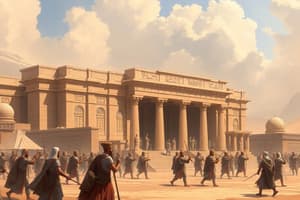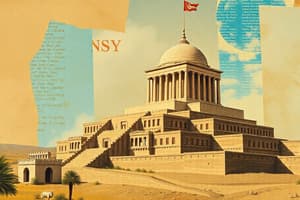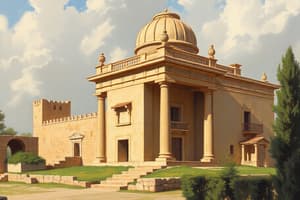Podcast
Questions and Answers
What architectural feature was characteristic of the Assyrian palace layout?
What architectural feature was characteristic of the Assyrian palace layout?
- A series of courts organized using orthogonal geometry (correct)
- A network of underground tunnels connecting different areas
- Circular courtyards surrounding a central temple
- A single large open space for public gatherings
What was the primary purpose of the lamassu statues found in Assyrian palaces?
What was the primary purpose of the lamassu statues found in Assyrian palaces?
- To serve as a platform for ceremonial events
- To serve as religious idols for worship
- To guard entrances and protect against evil (correct)
- To act as foundations for the palace walls
Which architectural element is particularly associated with Persian palaces, such as in Persepolis?
Which architectural element is particularly associated with Persian palaces, such as in Persepolis?
- The apadana, a large audience hall with columns (correct)
- The use of glazed polychrome brickwork
- The lamassu placed at the entrances
- The ziggurat with its seven stages
What was the Hall of Hundred Columns at Persepolis primarily designed for?
What was the Hall of Hundred Columns at Persepolis primarily designed for?
What artistic influence can be most strongly observed in Persian architecture and art?
What artistic influence can be most strongly observed in Persian architecture and art?
Which type of megalithic structure consists of a single, upright stone?
Which type of megalithic structure consists of a single, upright stone?
What is the primary construction method used in the Skara Brae settlement?
What is the primary construction method used in the Skara Brae settlement?
What is a defining characteristic of a dolmen?
What is a defining characteristic of a dolmen?
What was the primary purpose of Cromlechs?
What was the primary purpose of Cromlechs?
Besides Europe, where else can megalithic structures be found?
Besides Europe, where else can megalithic structures be found?
Which of these is notable for its corbel vault and three types of stones?
Which of these is notable for its corbel vault and three types of stones?
Where is Gobekli Tepe located?
Where is Gobekli Tepe located?
What was a key development in Mesopotamian civilization?
What was a key development in Mesopotamian civilization?
What type of masonry is characterized by the use of large, irregularly shaped stones without mortar, as employed by the Hittites?
What type of masonry is characterized by the use of large, irregularly shaped stones without mortar, as employed by the Hittites?
Which architectural element is described as an entrance hall with a stairway, pillars, and often featuring a double gateway with a corbeled arch and decorative friezes?
Which architectural element is described as an entrance hall with a stairway, pillars, and often featuring a double gateway with a corbeled arch and decorative friezes?
Hattusa, the ancient Hittite capital, is best known for which of the following?
Hattusa, the ancient Hittite capital, is best known for which of the following?
What is the primary function of the double wall fortifications with tunnels found in Hittite cities?
What is the primary function of the double wall fortifications with tunnels found in Hittite cities?
What distinguishes Assyrian palaces from those of earlier Mesopotamian civilizations?
What distinguishes Assyrian palaces from those of earlier Mesopotamian civilizations?
What are 'orthostats' in the context of Assyrian architecture?
What are 'orthostats' in the context of Assyrian architecture?
Which building material was NOT commonly used in Assyrian architecture?
Which building material was NOT commonly used in Assyrian architecture?
What was the purpose of the glazed polychrome bricks used by the Assyrians?
What was the purpose of the glazed polychrome bricks used by the Assyrians?
What is the primary function of the castrum in Roman architecture?
What is the primary function of the castrum in Roman architecture?
Which feature distinguishes the Mausoleum of Hadrian?
Which feature distinguishes the Mausoleum of Hadrian?
What architectural inspiration did the Triple Arch structure provide for later developments?
What architectural inspiration did the Triple Arch structure provide for later developments?
Which of the following is known as the Black Gate and dates back to 300?
Which of the following is known as the Black Gate and dates back to 300?
Which construction material was frequently combined with brickwork in early Christian architecture?
Which construction material was frequently combined with brickwork in early Christian architecture?
What function did the atrium serve in a basilica?
What function did the atrium serve in a basilica?
What structural feature is characteristic of a traditional basilica?
What structural feature is characteristic of a traditional basilica?
Which biblical symbol is associated with resurrection and immortality?
Which biblical symbol is associated with resurrection and immortality?
What is the architectural layout of the Mausoleum of Santa Constanza?
What is the architectural layout of the Mausoleum of Santa Constanza?
What is a defining feature of the Baptistery of the Orthodox?
What is a defining feature of the Baptistery of the Orthodox?
What material was primarily used to create the catacombs?
What material was primarily used to create the catacombs?
What is typically found at the apse of a basilica?
What is typically found at the apse of a basilica?
What is depicted in the wall art within a basilica?
What is depicted in the wall art within a basilica?
What important modification was made in the early Christian chapel in Dura Europos?
What important modification was made in the early Christian chapel in Dura Europos?
What architectural style influenced the construction of early Christian basilicas?
What architectural style influenced the construction of early Christian basilicas?
What is the primary building material used in early Chinese architecture?
What is the primary building material used in early Chinese architecture?
What architectural feature symbolizes the principles of heaven and earth in Chinese architecture?
What architectural feature symbolizes the principles of heaven and earth in Chinese architecture?
Which structure is considered the oldest surviving brick structure in China?
Which structure is considered the oldest surviving brick structure in China?
What is a distinctive feature of pagodas in Japanese architecture?
What is a distinctive feature of pagodas in Japanese architecture?
What does a Torii gate represent in Shinto shrines?
What does a Torii gate represent in Shinto shrines?
How is the room size in traditional Japanese dwellings typically determined?
How is the room size in traditional Japanese dwellings typically determined?
What is the primary purpose of the kondo in Japanese buddhist monasteries?
What is the primary purpose of the kondo in Japanese buddhist monasteries?
Which significant structure is known for its intricate timber truss systems?
Which significant structure is known for its intricate timber truss systems?
What is the historical significance of the Great Wall of China?
What is the historical significance of the Great Wall of China?
What type of gardens became prominent due to the Zen influence in Japanese architecture?
What type of gardens became prominent due to the Zen influence in Japanese architecture?
Flashcards
What is a Megalith?
What is a Megalith?
A large prehistoric stone structure, often consisting of multiple stones, used for various purposes like marking important places or serving as astronomical observatories.
What is a Menhir?
What is a Menhir?
A single upright stone block, often forming long rows called stone avenues.
What is a Dolmen?
What is a Dolmen?
A structure consisting of two upright stones supporting a horizontal slab, typically used as tombs.
What is a Cromlech?
What is a Cromlech?
Signup and view all the flashcards
What is Newgrange?
What is Newgrange?
Signup and view all the flashcards
What is Jericho?
What is Jericho?
Signup and view all the flashcards
What is Skara Brae?
What is Skara Brae?
Signup and view all the flashcards
What is Mesopotamia?
What is Mesopotamia?
Signup and view all the flashcards
Lamassu
Lamassu
Signup and view all the flashcards
Ziggurat
Ziggurat
Signup and view all the flashcards
Apadana
Apadana
Signup and view all the flashcards
Hypostyle Hall
Hypostyle Hall
Signup and view all the flashcards
Persepolis
Persepolis
Signup and view all the flashcards
Castrum
Castrum
Signup and view all the flashcards
Mausoleum
Mausoleum
Signup and view all the flashcards
Tombs
Tombs
Signup and view all the flashcards
Columbarium
Columbarium
Signup and view all the flashcards
Spolium
Spolium
Signup and view all the flashcards
Cyclopean masonry
Cyclopean masonry
Signup and view all the flashcards
Citadel
Citadel
Signup and view all the flashcards
Bit-hilani
Bit-hilani
Signup and view all the flashcards
Hattusaş
Hattusaş
Signup and view all the flashcards
Yazılıkaya
Yazılıkaya
Signup and view all the flashcards
Khorsabad
Khorsabad
Signup and view all the flashcards
Orthostats
Orthostats
Signup and view all the flashcards
Narthex
Narthex
Signup and view all the flashcards
Apse
Apse
Signup and view all the flashcards
Basilica
Basilica
Signup and view all the flashcards
Atrium
Atrium
Signup and view all the flashcards
Catacombs
Catacombs
Signup and view all the flashcards
Loculus
Loculus
Signup and view all the flashcards
Baptistery
Baptistery
Signup and view all the flashcards
Basilica of San Vitale
Basilica of San Vitale
Signup and view all the flashcards
Early Christian architecture
Early Christian architecture
Signup and view all the flashcards
What is a Pai-lou?
What is a Pai-lou?
Signup and view all the flashcards
What is a Chinese Pagoda?
What is a Chinese Pagoda?
Signup and view all the flashcards
What is a Tatami?
What is a Tatami?
Signup and view all the flashcards
What is a Naiku?
What is a Naiku?
Signup and view all the flashcards
What is a Torii?
What is a Torii?
Signup and view all the flashcards
What is a Kondo?
What is a Kondo?
Signup and view all the flashcards
What is the Horju-ji Monastery?
What is the Horju-ji Monastery?
Signup and view all the flashcards
What is a Zen Garden?
What is a Zen Garden?
Signup and view all the flashcards
What is the Songyue Pagoda?
What is the Songyue Pagoda?
Signup and view all the flashcards
What is the Tomb of Emperor Qin Shi Huangti?
What is the Tomb of Emperor Qin Shi Huangti?
Signup and view all the flashcards
Study Notes
Prehistoric Architecture
- Megalithic structures are large prehistoric stone structures, often comprising multiple stones, used to mark important events and places, or as communal tombs.
- Megaliths are found across the globe, with a significant concentration in Europe.
- Menhirs are isolated single upright stones, often arranged in rows, and sometimes a number of them form stone avenues.
- Dolmens are two upright stones supporting a horizontal slab, sometimes forming long corridor-like tombs for important individuals.
- Cromlechs are stone circles with stones arranged in a circle and interlocked with stone lintels. They were once thought to have been religious centers.
Tombs
-
Newgrange is an Irish prehistoric tomb (3200 BC), constructed using various stones without mortar.
-
Jericho (ca 8000 BC) was an early, fortified settlement.
-
Catal Huyuk (6500-5700 BC) was a Turkish settlement with dwellings without streets.
-
Göbekli Tepe (9500 BC, Turkey) is considered one of the oldest megalithic sites.
-
Skara Brae, a Neolithic village in Scotland (3180 BC), was built using stones without mortar.
-
Menhirs in Carnac, France (5000-2000 BC)
-
Dolmen Menga, Spain (2500 BC) was a long tomb
-
Cromlech Stonehenge, UK (1800 BC)
Mesopotamian Architecture
- Sumerians (4000 BC) were the first civilization, creating written language and numerical systems, making calculated calendars, inventing the wheel and the plow.
- Buildings were made of sun-baked bricks.
- Roofs were constructed from lightweight wood or reeds.
- Temples were important in urban planning, located at the heart of communities and frequently elevated on platforms.
- Ziggurats are tiered towers with a temple on the top, connecting heaven and earth.
- Temples were elevated for protection from floodwaters, adding visual significance.
- Houses were massive blocks without windows, with courtyards, making use of roof terraces for living spaces.
Hittite, Assyrian, Persian and Phoenician Architecture
- Hittites (1800–1200 BC, modern-day Turkey) built cities with large protective walls incorporating entrances with statues of lions or sphinxes.
- Hattiuşaş was the ancient Hittite capital with temple structures.
- Assyrians (1500-612 BC) utilized elaborate materials like bronze gates, cedar supports, iron, and glazed polychrome bricks.
- Palaces featured courtyards, private apartments, and throne rooms.
- Persian architecture (6th century BCE – 330 BCE): Stone, wood, and brick were building materials with strong inspirations from conquered cultures.
- Temples of fire reflected a devotion to the sun and fire.
- Persepolis consisted of a large palace with terraces, audience halls, and a large roof space to accommodate 10,000 people.
- The Persian architecture reflected a significant influence from conquered cultures.
Ancient Egyptian Architecture
-
Egyptian cities orientated according to the four cardinal points with the N–S axis as the natural axis of the city.
-
Old Kingdom (2700-2200 BC) featured pyramids of Sakkara/Memphis.
-
Middle Kingdom (2200–1500 BC) was known for rock temples in Thebes.
-
New Kingdom (1500–1100 BC) was characterized by temples in Luxor.
-
Pyramids represented belief in the afterlife.
-
Obelisks are tall, four-sided, monolithic structures typically used to mark entrances to temples and celebrate rulers.
-
Pylons are tall, rectangular structures serving as monumental gate structures to temples.
-
Mastabas served as tombs for upper-class individuals.
-
Pyramids were monumental royal tombs designed with sloping walls culminating in a pyramid cap.
-
The Great Sphinx was a large statue with a lion's body and a human head, likely meant to guard the Giza Pyramids
Minoan and Mycenaean Architecture
-
Minoan architecture (2000-1400 BCE) in Crete focused on unfortified cities and palaces, constructed from various materials and characterized by features like columned entrances, courtyards, and light wells.
-
Mycenaean architecture (1600-1100 BCE), prominent in Greece, is characterized by well-fortified cities with impressive walls made of cyclopean masonry without mortar.
-
Lion Gate is the primary entrance to Mycenae, featuring a lintel supported by two sculpted stone lions.
-
Tombs like the Treasury of Atreus featured corbelling techniques used to create a vaulted chamber.
Ancient Roman Architecture
- Ancient Roman architecture (6th century BCE-395 BCE) was known for its remarkable engineering skills.
- Building materials included concrete, stone, wood, fired bricks, combinations of stone and brickwork, and different types of masonry.
- Opus cementicum: Roman concrete was a mix of cement, gravel, and water for strong construction.
- Temples and residential homes were built in various geometrical forms for diverse uses.
- Amphitheaters like the Colosseum served as large public spaces for gladiatorial combats and various entertainments.
- Aqueducts and bridges showed advanced engineering.
Early Christian Architecture
-
Early Christian architecture (313-550 AD) used different materials such as brickwork combined with poured concrete and stone.
-
Vaults were used frequently.
-
Basilicas, often with longitudinal naves and apses, served as important buildings.
-
Basilicas combined Roman architectural elements.
-
Baptisteries were small dedicated spaces for baptisms.
-
Catacombs were underground burial chambers.
Byzantine Architecture
- Byzantine architecture (330–1453 AD) in the Eastern Roman Empire used materials such as fired brick, stone, and marble.
- Domes were commonly used, centrally placed over the central nave, as well as the building's main feature.
- Mosaics, especially on ceilings, and frescoes decorated the interiors.
Chinese and Japanese Architecture
- Early Chinese architecture (pre-3rd century) is rare due to being primarily built out of wood.
- Pagodas, used in Buddhist temples, were multi-storied tower structures.
- Gardens were integrated in many Chinese sites for artistic appreciation of nature and harmony with it.
- Japanese architecture is characterized by its use of natural materials such as wood, with harmony and aesthetics being highly considered.
- Shinto shrines served as places for religious observance, reflecting their deep connection with nature.
Studying That Suits You
Use AI to generate personalized quizzes and flashcards to suit your learning preferences.




